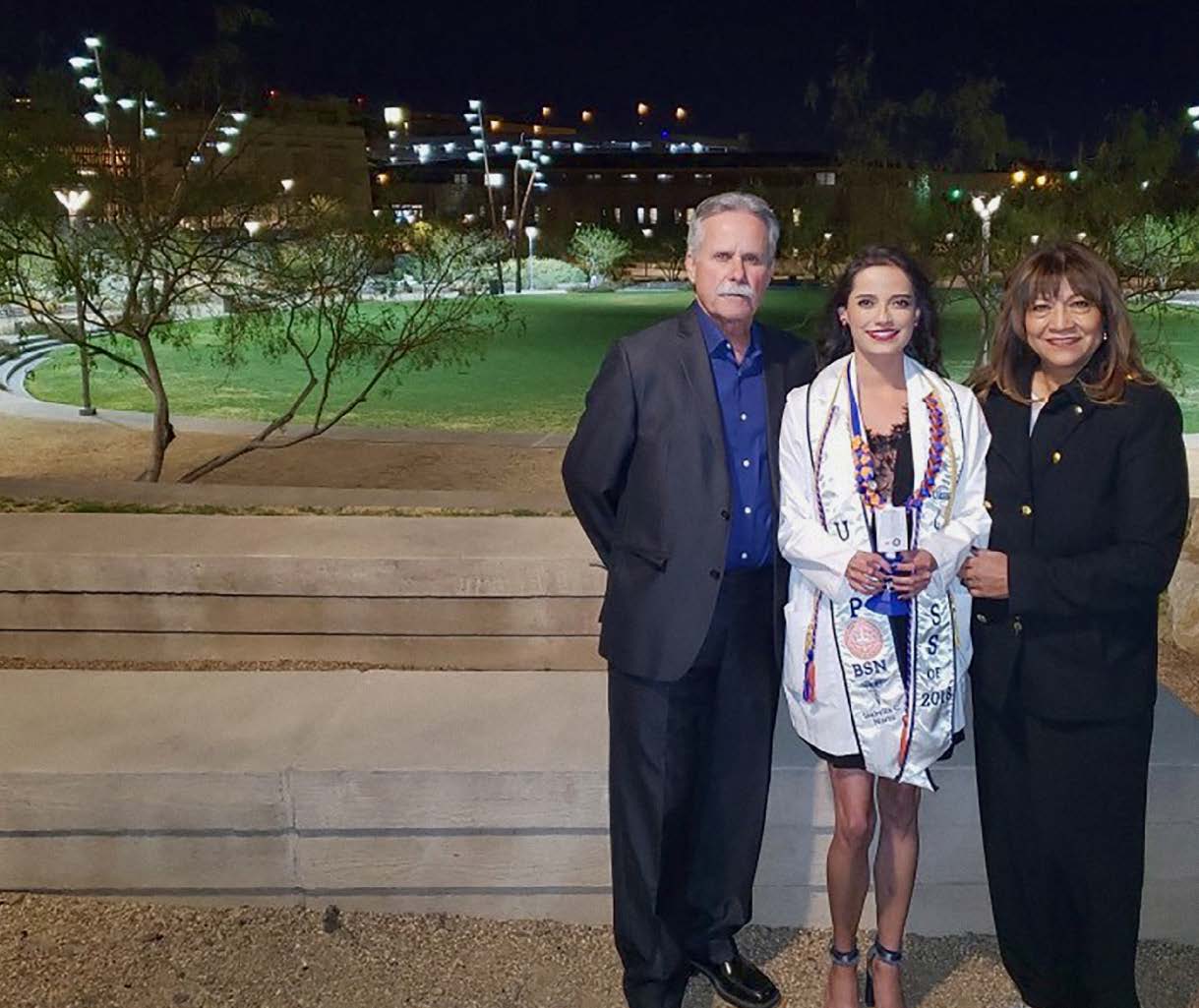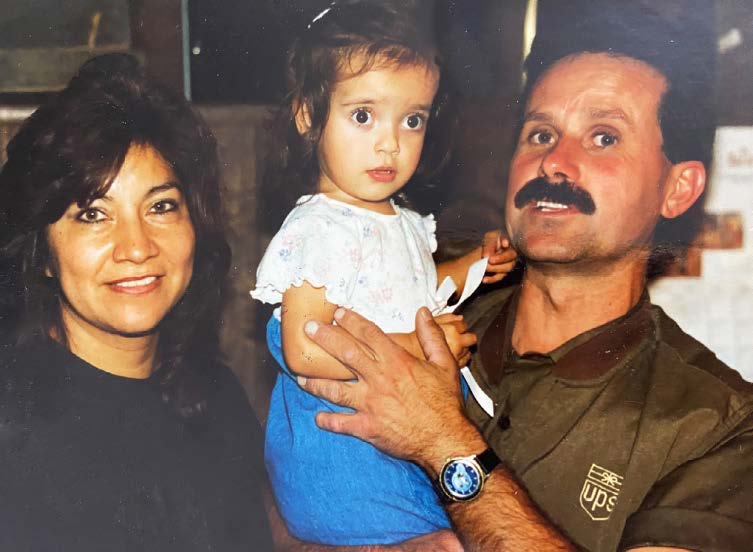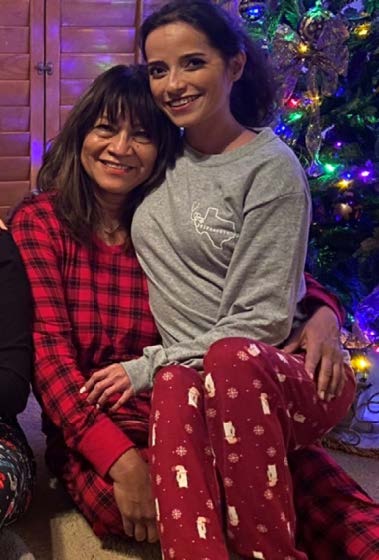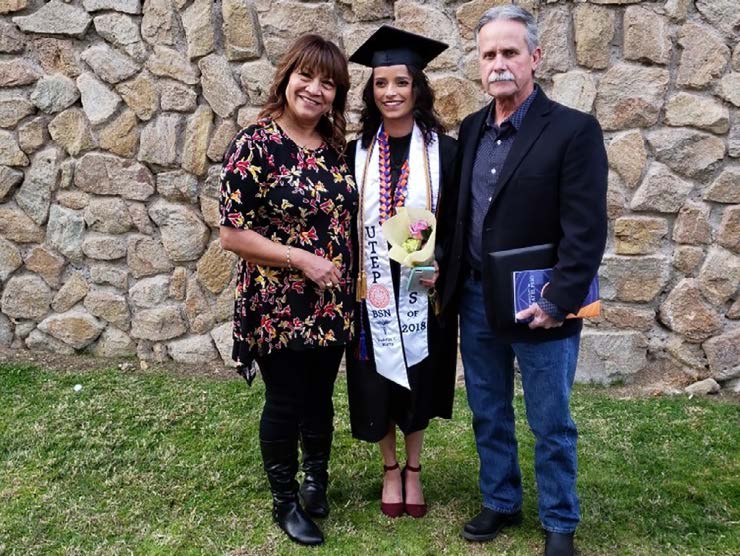ANNUAL HEALTH CARE ISSUE

OUTSTANDING ACHIEVEMENT: Raul, Bella and Frances Marin following Bella's graduation from the University of Texas at El Paso. She graduated Summa cum Laude for both her Bachelor's degree in Psychology and her Bachelor of Science in Nursing degree.
PARENTING A CHILD WITH A LIFE-THREATENING CONDITION
BY KATIE WRIGHT
Parenting a child through all stages of life can be challenging and rewarding. In school, children are introduced to other children their age, and eventually experience a degree of independence from their parents. Children face their own challenges of friendships, animosities, and, unfortunately, sometimes bullying. As they grow in their independence through childhood and teenage years, they also push their boundaries to an even higher degree by participating in sports and extracurricular activities that further shape their desires and goals for the future.
When a child is living with a life-threatening condition, it adds complexity to parenting. In grade school, it is challenging for parents to balance a child's desire to participate in physical activity while requiring they follow recommended medical guidelines; and attempting to inform teachers and their administrations about the condition can be downright overwhelming. When the teenage years arrive, there are a new set of emotional hurdles for the parents and the adolescents, who want more independence.
Frances Marin, of El Paso, Texas, didn't know her daughter, Bella, was living with a life-threatening condition called VEDS (Vascular Ehlers-Danlos syndrome) until she was ten years old. However, Frances knew something wasn't right the moment Bella was born. She came six weeks early due to premature rupture of the membranes and remained in the NICU for two weeks because her lungs weren't fully developed. As a child, she would get huge bruises without explanation and an injury that would have been a simple scrape for someone else necessitated a trip to the ER for stitches. Bella was also constantly achy, and her veins were visible across her body. When she entered school, kids would make fun of her and tell her that her hands looked like those of an old woman.
Bella's pediatrician repeatedly attempted to reassure Frances that all of these things were normal for some kids. But Bella had to go to the doctor so often; Frances knew there was something wrong. By the time Bella was five, Frances pushed even harder for answers. She was referred to a hematologist/oncologist, where testing resulted in a diagnosis of Von Willebrand's disease, a blood clotting disorder that results in excessive bruising and bleeding.
With an answer for the severe bruising now in hand, Frances made an effort to let the school personnel know about Bella's condition. Contact sports were out for Bella, but Frances was grateful for the diagnosis. Frances actually feared that, without this diagnosis, she may be wrongly reported to child protective services for the heavy bruising.
After five years of taking Bella to doctor appointments for Von Willebrand's, Frances became unsatisfied with this diagnosis because Bella continued to have nosis because Bella continued to have issues with her skin tearing and bruising without trauma, and she didn't bleed as much as Frances thought someone with Von Willebrand's should. When she finally brought her concerns up to the hematologist/oncologist, he agreed and performed a skin biopsy. By this time, it was 2004 and Bella was 10 years old. What came three months later was a bombshell for Frances. Bella was diagnosed with VEDS. They were told that VEDS is very rare and that is has no treatment or cure. Additionally, Bella was now not allowed to participate in sports, run, or do any strenuous exercise. She could not undergo any surgeries unless it was a matter of life or death and she was told she could never become pregnant because pregnancy and delivery could kill her.
Frances learned that individuals with VEDS are prone to spontaneous, life-threatening emergencies, like tears and ruptures in their arteries, tears in the intestinal walls, and lung collapses. The absolute worst part – the family was told that Bella would not live past 42. Frances just wanted to wrap Bella in a bubble.
After her initial shock, Frances made the decision to try to raise Bella to live as normal of a life as possible. She dedicated herself to being her advocate because many of the physicians she met had not heard of VEDS, nor did they have any experience "It broke my heart to not allow Bella to do the things her friends were doing, like roller skating, ice skating, and playing kickball and softball. Seeing that your child can't have a normal life is a hard thing to bear." caring for an individual with VEDS.
"As her parent, I knew I had to learn as much about VEDS as I could, so I could be prepared for any emergency at any time." said Frances
said Frances Although Frances was dedicated to giving Bella a normal life after diagnosis, it was very difficult. Each vacation required extra preparation because Frances always made an effort to be close to a major hospital. Even going to Disneyland was difficult because Bella wanted to ride the rollercoasters and Frances had to say no. The easier rides would still give Bella huge bruises. Frances knew then that Bella's body would not let her live a normal life.
"It broke my heart to not allow her to do the things her friends were doing, like roller skating, ice skating, and playing kickball and softball. She loved the trampoline, but we had to get rid of it. She loved to play volleyball and tetherball, but even her fingers would get very bruised," said Frances. "Seeing that your child can't have a normal life is a hard thing to bear." It was hard on Bella, too.
"I still remember her sad eyes one time when all her friends were having fun and running around on 'water day' at school. She had a ligament tear in her leg and couldn't participate," said Frances.
couldn't participate," said Frances. From Bella's perspective, as a kid she was sad she couldn't play sports like other kids -although in hindsight, she wonders if knowing that she couldn't participate just increased her desire.
increased her desire. "It was hard, and it sucks feeling different when you are a kid," Bella explained. "I grew up in a really big family and my cousins were around a lot. They loved to wrestle and play rough, and I couldn't. Sometimes I was also scared that my cousins would hate me if I got hurt and they got in trouble."


CLOSE TO THE HEART: (Above, left) Frances, Bella and Raul; (Above, right) Frances and Bella together on Christmas day. After the initial shock of the diagnosis, Frances made the decision to try to raise Bella to live as normal of a life as possible. She dedicated herself to being her advocate because many of the physicians she met did not have any experience caring for an individual with VEDS.
Bella sometimes struggled with feeling like a burden to her friends and family. "When I go to concerts, I can't be up front because all of the pushing and crowding," Bella said. "For the most part, I have had really great friends and family who understand, but it really doesn't take away that feeling." By the time Bella turned 16, she was not only a frequent visitor to her doctors and local emergency rooms, but she also began a stretch of hospitalizations. At 18, she had two emergency intestinal surgeries and Frances thought she was going to lose her, but Bella made it through.
Bella continued on to college and graduated Summa cum Laude for both her Bachelor's degree in Psychology and her Bachelor of Science in Nursing degree. She was even the Banner Bearer for her class – a high honor bestowed on students with outstanding academic achievements. These accomplishments were not easy due to her accomplishments were not easy due to her daily struggles with chronic fatigue, chronic pain, a muscle tear that put her in a wheelchair for almost two years, additional hospitalizations, and numerous trips to the emergency room. "Nursing school was really one of the hardest things I have ever done," said Bella. "I went in knowing that I might not be able to handle nursing, but I really wanted to have that nursing back ground and understanding. My mom was such a huge support for me emotionally during that time, too."
After Bella received her degree in nursing, she was unable to work for almost a year due to health complications. "I was so sad for her because she was hired at the hospital and had to quit before she even started," Frances said. "All her healthcare providers advised her not to work in a hospital setting, telling her that her fragile body would not be able to tolerate the long shifts."
Then, last year, Bella was given an opportunity to work as a research nurse, a job that was 12 hours away from home. Bella had worked so hard and overcome so much to get her nursing degree, and felt the opportunity to work with a researcher who is focused on VEDS and related conditions was perfect for her.
"It was a hard decision, but it was a great opportunity," said Frances. "I encouraged her to take the job, even though I knew how stressed I would be with her so far away. It is hard, and I wake up every morning and text her to make sure she has survived another day." For Bella, the scariest part of her new job is living alone, but it has been a lot easier than she thought it would be because she is so connected to the experts at the hospital where she works. The periods of fatigue she experiences also make it difficult, and she feels lucky to be working with physicians who understand VEDS and help her balance her life.

MOMENTOUS EVENTS: Bella and her parents celebrating Bella's graduation from UTEP. Bella was the Banner Bearer for her class, a high honor awarded for outstanding academic achievements.
"I am so grateful to have my mom's support," Bella said. "Because I got my diagnosis at such a young age and my mom helped educate me so much, it has really helped prepare me and helped me stay on top of my health."
Bella is also grateful that her mom took such care when she was a child to educate others in a way that didn't make her feel that her diagnosis was the only important thing about her.
"I wouldn't have been able to come so far in my life without both of my parents supporting my decisions and understanding that although I have such a scary medical condition, I need to live my life and be happy," said Bella. "I have such amazing parents, siblings, and a large extended family who have supported me physically, emotionally, and financially in so many different ways. Although I have VEDS, I consider myself very blessed."
consider myself very blessed." Frances is extremely proud of her daughter for her daughter for her accomplishments and drive.
"My admiration for my daughter is so strong because she does all of this with a smile," said Frances. "She doesn't show what is going on inside her body. She has the daily task of having to choose which mountains to climb and, even when it seems impossible, she does it with grace and a smile. The constant awareness that a potential catastrophic event could happen at any time is hard for the whole family, but I know we have come a long way since her diagnosis with VEDS in 2004."
Research into VEDS is still limited, especially in the area of physical activity. Expert consensus is to avoid strenuous physical activity, heavy weight lifting, sudden spikes in blood pressure, and collision sports.
Unfortunately, especially in the area of physical activity. Experts say to avoid strenuous physical activity, heavy weight lifting, sudden spikes in blood pressure, and collision sports. many individuals who follow the exercise guidelines may still suffer serious complications. The community experiences loss at a devastating rate. Only 50% of individuals with VEDS live to the age of 51, and many start to experience life-threatening emergencies as they enter their late teens and 20s. By the age of 40, 80% have experienced a major medical event. To make matters worse, knowledge among medical professionals is limited. This can be deadly in an emergency situation.
While physician knowledge, research, and expert care in VEDS is limited, the good news is that awareness and understanding are growing. Together with mem bers of the community, physicians, and researchers, The VEDS Movement, a new division of The Marfan Foundation, is paving the way for a longer, better life for individuals with VEDS. Bella and Frances are both proud to be part of the Movement's Steering Committee, helping to lead the charge forward to save lives.
"Now, the community has more researchers and physicians involved than ever before," said Katie Wright, director of The VEDS Movement who also lives with VEDS. "With the leading physicians and researchers on the Foundation's Professional Advisory Board, we are hopeful that groundbreaking research and more widespread knowledge about VEDS among the medical community is on the horizon."•
ABOUT THE AUTHOR:
Katie Wright, the Director of The VEDS Movement, was diagnosed with VEDS in 2017. Her delayed diagnosis lit a torch to raise awareness for VEDS. Katie hosts a podcast featuring the stories of others living with VEDS, is on the Advisory Group for the VEDS Collaborative, and leads The VEDS Movement with a passion for connecting others with VEDS and providing them with resources to empower them in their lives with this condition. Learn more about VEDS at TheVEDSMovement.org.